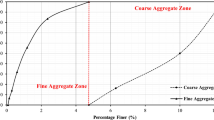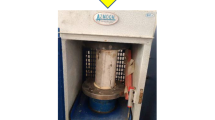Abstract
Flexural strength and toughness of dune sand concrete (DSC) can be improved by reducing the water-to-cement ratio, adding fillers to improve the compactness of the matrix, or incorporating steel fibers. The incorporation of fibers and fillers can increase the viscosity and yield stress and necessitates higher dosage of high-range water-reducer to maintain the desired fluidity. The mixture proportioning of DSC involves tailoring several parameters to achieve adequate fresh and mechanical properties. The optimization procedure of DSC reinforced with steel fibers often necessitates several trial batches before establishing optimal balance among the various mixture parameters that affect workability and mechanical properties of concrete. DSC proportioned with 0.46–0.73 w/c ratio, 65–335 kg/m3 of limestone filler, and 0–108 kg/m3steel fiber was evaluated. The study was undertaken to model the influence of w/c, limestone filler, and fiber contents on air content, plastic viscosity, compressive and flexural strength characteristics of the DSC. Experimental test results showed that the incorporation of 94.5 kg/m3 of fiber resulted in a significant improvement in flexural strength (up to 11.5 MPa). Statistical models established using a central composite design indicate that the w/c has the greatest effect on air content, plastic viscosity, and compressive strength of DSC than limestone filler and fiber. However, the fiber is shown to have the greatest effect on flexural strength. The established models showed that the use of limestone filler can compensate for the reduction in compressive and flexural strengths due to the increase in w/c. Trade-off between w/c, limestone filler content, and fiber dosage to optimize mixture proportioning to enhance the mechanical properties of DSC without adversely affecting fluidity is discussed.


Similar content being viewed by others
References
Al-Harthy, A.S.; Abdel Halim, M.; Taha, R.; Al-Jabri, K.S.: The properties of concrete made with fine dune sand. Constr. Build. Mater. 21, 1803–1808 (2007)
Benmalke, M.: Contribution to develop dune sand concrete for structural elements. Master thesis, Ecole Nationale polytechniqued’Algérie, Juin 108p. (in French) (1993)
Batata, A.; Zerouni, M.: Dune sand concrete—properties and performance. MATLOC Congres, Biskra, December 3, CNERIB, Algérie, 159–165 (in French) (1991)
Breysse D., Alain D., Attar A., Chauvin J.J.: Contribution of aggregate on mechanical properties of dune sand. Revue Française de génie civil. 1, 89–114 (1997)
Bédérinaa, M.; Khenfer, M.M.; Dheillyc, R.M.; Quéneudeccm, M.: Reuse of local sand—effect of limestone filler proportion on the rheological and mechanical properties of different sand concretes. Cement Concrete Res. 35, 1172–1179 (2005)
SABLOCRETE. Sand Concrete National Research & Development Project (in French). ENPC Press, France (1996)
Brouwers, H.J.H.; Radix, H.J.: Self-compacting concrete—the role of the particle size distribution. In: First International Symposium on Design, Performance and Use of SCC, Changsha, Hunan, China, pp. 109–118 (2005)
Hadjoudja, M.: Physico-mechanical and durability performance of dune sand concrete—influence of cure treatment and filler addition. Master thesis (in French). Université ATledji de Laghouat, Algérie, Octobre 168 p (2001)
Chanvin, J.J.; Grimaldi, G.: les bétons de sable. Bulletin de liaison des LPC 157, 9–15 (in French) (1988)
Rossi, P.: Steel fiber reinforced concretes (SFRC): An example of French research. ACI Mater. J. 91, 273–279 (1994)
Goupy, J.: Practicing Experimental Design Plans. Dunod, Paris (2005)
Montgomery, D.C.: Design and Analysis of Experiments, 5th edn. Wiley, New York (2001)
Sado, G.; Sado, M.C.: Experimental Design Plans—From Experimentation to Quality Insurance (in French). AFNOR Technique, Paris (1991)
Benoist, D.; Tourbier, Y.; Germain-Tourbier, S.: Experimental plans-Analyse and design. Lavoisier Tec & Doc, Paris (in French) (1995)
Sheffe, H.: The Analysis of Variance. Wiley, New York (1964)
Estellé, P.; Lanos, C.; Perrot, A.; Amziane, S.: Processing the vane shear flow data from coquette analogy. Appl. Rheol. 18(3), 34037-1–34037-6 (2008)
Dugue, D.: Applied and Theoretical Statistics. Masson, Paris (in French) (1958)
Yahia, A.; Tanimura, M.; Shimoyama, H.: Rheological Properties of Highly-flowablemortar containing limestone filler—effect of powder content and W/C ratio. Cement Concrete Res. 35, 532–539 (2005)
Yahia A., Khayat K.H.: Experiment design to evaluate interaction of high-range water-reducer and antiwashout admixture in high-performance cement grout. Cement Concrete Res. 31, 749–757 (2001)
Author information
Authors and Affiliations
Corresponding author
Rights and permissions
About this article
Cite this article
Hadjoudja, M., Khenfer, M.M., Mesbah, H.A. et al. Statistical Models to Optimize Fiber-Reinforced Dune Sand Concrete. Arab J Sci Eng 39, 2721–2731 (2014). https://doi.org/10.1007/s13369-013-0774-z
Received:
Accepted:
Published:
Issue Date:
DOI: https://doi.org/10.1007/s13369-013-0774-z




